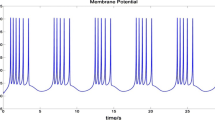Abstract
Spike activity of respiratory neurons of the ventrolateral medullary regions was studied under conditions of blocking of synaptic transmission. The experiments were carried out on superfusedin situ semi-isolated medullo-spinal preparations (SIMSP) of newborn (1st day of life) and 4- to 5-day-old rats. Part of the pre-inspiratory and (to a somewhat lesser extent) expiratory neurons of newborn rats appeared most resistive to superfusion of preparations with a low-Ca2+ (0.2 mM) and Mg2+-rich (5.0 mM) solution. Spike activity in some neurons of these groups was preserved up to 40 and 25 min, respectively, after mass inspiratory discharges in then. phrenicus had disappeared. Similar neurons in 4- to 5-day-old SIMSP were less resistive. Inspiratory neurons in animals of both age groups demonstrated no pacemaker properties. Coagulation of the regions where pre-inspiratory neurons are localized (the retrofacial zone) did not evoke irreversible blockade of respiratory rhythm in all SIMSP of 4- to-5-day-old rats and in most SIMSP of newborn animals. At the same time, coagulation of the zone where inspiratory neurons are concentrated (the pre-Bötzinger complex) resulted in the blockade of respiratory rhythm in all SIMSP, with no exceptions.
Similar content being viewed by others
References
G. C. Salmoirhai, and von R. Baumgarten, “Intracellular potentials from respiratory neurones in brainstem of cat and mechanisms of rhythmic respiration,”J. Neurophysiol,23, 14–26 (1961).
M. I. Cohen, “Neurogenesis of respiratory rhythm in the mammal,”Physiol. Rev.,59, No., 1105–1173 (1979).
D. W. Richter, “Generator and maintenance of the respiratory rhythm,”J. Exp. Biol.,100, No. 1, 93–107 (1982).
J. L. Feldman and C. L. Cleland, “Possible role of pace-maker neurones in mammalian respiratory rhythmogenesis,” in:Cellular Pacemakers, Wiley, New York (1982), pp. 104–128.
H. Onimaru, A. Arata, and I. Homma, “Localization of respiratory rhythm-generating neurones in the medulla of brainstemspinal cord preparations from newborn rats,”Neurosci. Lett. 78, No. 2, 152–155 (1987).
J. C. Smith, H. H. Ellenberger, K. Ballanyi, et al., “Pre-Bötzinger Complex: a brainstem region that may generate respiratory rhythm in mammals,”Sci. Wash. DC,254, 726–729 (1991).
J. C. Smith, G. D. Funk, S. M. Johnson, and J. L. Feldman, “A hybrid pacemaker-network model for the respiratory oscillator in mammals,”Soc. Neurosci. Abstr.,18, 1279 (1992).
H. Onimaru and I. Homma, “Respiratory rhythm generator neurones in medulla of brainstem-spinal cord preparation from newborn rats,”Brain Res.,403, No. 3, 380–384 (1987).
H. Onimaru, A. Arata, and I. Homma, “Firing properties of respiratory rhythm generating neurones in the absence of synaptic transmission in rat medullain vitro.”Exp. Brain Res.,76, No. 3, 530–536 (1989).
S. M. Johnson, J. C. Smith, G. D. Funk, and J. L. Feldman, “Pacemaker behaviour of respiratory neurons in medullary slices from neonatal rat,”J. Neurophysiol.,72, No. 6, 2598–2608 (1994).
H. Onimaru, A. Arata, and I. Homma, “Inhibitory synaptic inputs to the respiratory rhythm generator in the medulla isolated from newborn rats,”Pflügers Arch,417, No. 4, 425–432 (1990).
G. D. Funk, J. C. Smith, and J. L. Feldman, “Generation and transmission of respiratory oscillations in medullary slices: role of excitatory amino acids,”J. Neurophysiol.,70, No. 4, 1497–1515 (1993).
E. Di Pasquale, R. Monteau, and G. Hilaire, “Involvement of the rostral ventrolateral medulla in respiratory genesis during the perinatal period: anin vitro study in newborn and fetal rats,”Dev. Brain Res.,78, 243–252 (1994).
T. Suzue, “Respiratory rhythm generation in thein vitro brain stem-spinal cord preparation of the neonatal rat,”J. Physiol,354, 173–184 (1984).
V. A. Marchenko, V. B. Fenik, N. N. Preobrazhenskii, and M. M. Seredenko, “Respiratory activity generated by semi-isolated medullo-spinal preparation and recorded from the phrenic nerve of newborn rats,”Neirofiziologiya/Neurophysiology,27, No. 5/6, 387–395 (1995).
V. A. Marchenko, V. B. Fenik, L. P. Voitenko, and I. A. Osadchenko, “Parameters of discharges of respiratory neurons of the ventrolateral medullary regions in early postnatal rats,”Neirofiziologiya/Neurophysiology,28, No. 4/5, 107–117 (1996).
O. P. Minster, B. N. Ugarov, and V. V. Vlasov,Technique of Processing of Medical Information [in Russian], Vyscha Shkola, Kiev (1991), pp. 5–76.
P. Schweitzer, G. Fortin, J. Belolil, and C. J. Champagnat, “In vitro study of newborn rat brain maturation implication for sudden infant death syndrome, ”Neurochem. Int.,20, No. 1, 109–112 (1992).
S. Takashima, T. Mito, and H. Yamanouchi, “Developmental brain-stem pathology in sudden infant death syndrome,”Acta Pediatr. Jpn,36, No. 3, 317–320 (1994).
V. A. Marchenko, V. B. Fenik, N. N. Preobrazhenskii, and M. M. Seredenko, “Participation of the opioid- and serotonergic systems of the ventrolateral medullary regions in the control of respiratory activity in early postnatal rats,Neirofiziologia/Neurophysiology,28, No. 1, 62–73 (1996).
M. Smialowska, A. Bal, Z. Soltys, and J. Kaluza, “Monoamine distribution on the ventral surface of the rat medulla oblongata,”J. Neural Transm,63, 13–29 (1985).
D. Morin, S. Hennequin, r. Monteau, and G. Hilaire, “Serotonergic influences on central respiratory activity: anin vitro study in the newborn rat,”Brain Res.,535, 281–287 (1990).
J. R. Holtman, L. J. Marion, and D. F. Seck, “Origin of serotonin-containing projections to the ventral respiratory group in the rat,”Neuroscience,37, 541–552 (1990).
K. A. King and J. R. Holtman, “Characterization of effects of activation of ventral medullary serotonin receptors subtypes on cardiovascular and respiratory motor outflow to the diaphragm and larynx,”J. Pharmacol. Exp. Ther.,252, No. 2, 665–674 (1990).
Author information
Authors and Affiliations
Additional information
Neirofiziologiya/Neurophysiology, Vol. 28, No. 6, pp. 273–284, November–December, 1996.
Rights and permissions
About this article
Cite this article
Marchenko, V.A., Voitenko, L.P., Volgin, D.V. et al. Pacemaker properties of respiratory neurons of the ventrolateral medullary regions in early postnatal rats. Neurophysiology 28, 214–222 (1996). https://doi.org/10.1007/BF02252854
Received:
Issue Date:
DOI: https://doi.org/10.1007/BF02252854




